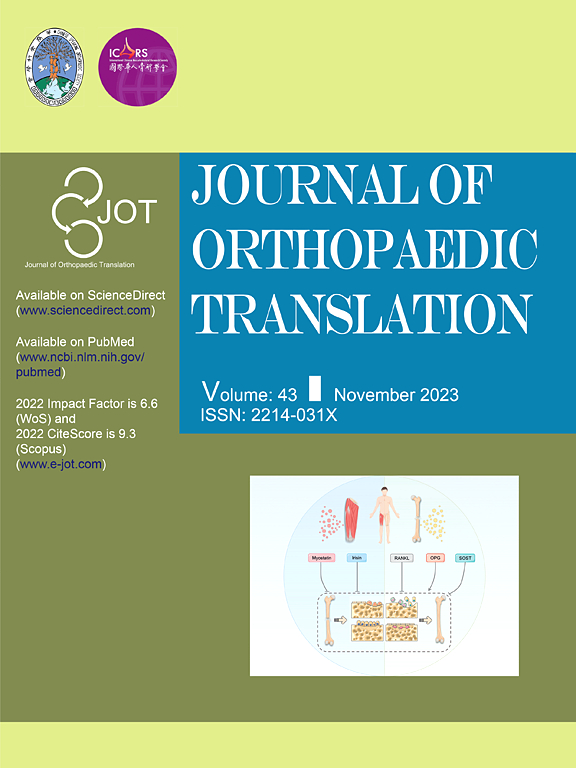Establishment and characterization of an inflammatory cartilaginous organoids model for organoid transplantation study
IF 5.9
1区 医学
Q1 ORTHOPEDICS
引用次数: 0
Abstract
Background
Transplantation of cartilaginous organoids for repairing cartilage defects in osteoarthritis represents a novel treatment approach. However, A controversial argument remains about whether cartilaginous organoids derived from the differentiation of bone marrow mesenchymal stem cells (BMSCs) in the three-dimensional (3D) environment are strictly organoids and whether the inflammatory microenvironment would affect the success rate of organoid transplantation. This study characterized 3D BMSC-derived cartilaginous organoids and developed an inflammatory organoid model to better understand the transcriptomic changes in the organoids induced by the microenvironment when transplanted into the knee with osteoarthritis.
Methods
Spatial growth BMSCs were generated and cultured in the cartilage differentiation medium to establish cartilaginous organoids. The model was characterized in both morphology and biology aspects. Subsequently, IL-1β induced inflammatory cartilaginous organoids were established and the transcriptomic sequencing was performed to investigate gene expression changes.
Results
BMSC-derived cartilaginous organoids were characterized by histology and immunofluorescence. Both Alcian blue and Safranin O staining revealed abundant articular cartilage extracellular matrix (ECM) in the organoids. The expression of cartilage specific ACAN and Col2A1 was confirmed by immunofluorescence. The organoids had the biological ability to repair cartilage defects. IL-1β induced inflammatory cartilaginous organoids were established and mRNA sequencing revealed downregulation of pathways related to cell adhesion and extracellular matrix organization. Upregulation of IL-6, TNF-α, CCL2 and CXCL1 was confirmed.
Conclusion
We thoroughly validated and characterized BMSC-derived cartilaginous organoids and established the inflammatory cartilaginous organoid models. This study revealed that the attenuation in cell adhesion and ECM formation of organoids induced by inflammatory chemokines may decrease the success rate and effectiveness of organoids auto-transplantation for fixing cartilage defects in the inflammatory microenvironment of the OA joint.
The translational potential of this article
By establishing and validating an in vitro inflammatory cartilaginous organoid model, this study provides a robust platform to examine how inflammatory mediators influence cartilage-like constructs. These findings enable the identification of targeted interventions to enhance the organoids’ resilience against the inflammatory environment commonly found in osteoarthritic joints. Ultimately, this strategy offers a novel avenue for improving transplant success and promoting cartilage defect repair in patients with OA, thereby contributing valuable insights and potential clinical applications in regenerative medicine.

类器官移植研究中炎性软骨类器官模型的建立与表征
软骨类器官移植修复骨关节炎软骨缺损是一种新的治疗方法。然而,关于骨髓间充质干细胞(BMSCs)在三维(3D)环境中分化产生的软骨类器官是否严格意义上的类器官,以及炎症微环境是否会影响类器官移植的成功率,目前仍存在争议。本研究表征了bmsc衍生的三维软骨类器官,并建立了炎症类器官模型,以更好地了解微环境诱导的类器官移植到骨关节炎膝关节时的转录组变化。方法制备空间生长的骨髓间充质干细胞,在软骨分化培养基中培养,建立软骨类器官。该模型在形态学和生物学两个方面进行了表征。随后,建立IL-1β诱导的炎性软骨类器官,并进行转录组测序以研究基因表达变化。结果骨髓间充质干细胞来源的软骨类器官具有组织学和免疫荧光特征。阿利新蓝和红花素O染色显示类器官中有丰富的关节软骨细胞外基质(ECM)。免疫荧光法证实了软骨特异性ACAN和Col2A1的表达。类器官具有修复软骨缺损的生物学能力。建立了IL-1β诱导的炎性软骨类器官,mRNA测序显示细胞粘附和细胞外基质组织相关通路下调。证实了IL-6、TNF-α、CCL2和CXCL1的上调。结论我们对骨髓间充质干细胞衍生的软骨类器官进行了充分的验证和表征,并建立了炎性软骨类器官模型。本研究发现炎症趋化因子诱导的类器官细胞粘附和ECM形成的衰减可能会降低类器官自体移植修复OA关节炎症微环境下软骨缺损的成功率和有效性。通过建立和验证体外炎性软骨类器官模型,本研究为研究炎症介质如何影响软骨样结构提供了一个强大的平台。这些发现能够确定有针对性的干预措施,以增强类器官对骨关节炎关节中常见的炎症环境的恢复能力。最终,该策略为提高OA患者的移植成功率和促进软骨缺损修复提供了一种新的途径,从而为再生医学提供了有价值的见解和潜在的临床应用。
本文章由计算机程序翻译,如有差异,请以英文原文为准。
求助全文
约1分钟内获得全文
求助全文
来源期刊

Journal of Orthopaedic Translation
Medicine-Orthopedics and Sports Medicine
CiteScore
11.80
自引率
13.60%
发文量
91
审稿时长
29 days
期刊介绍:
The Journal of Orthopaedic Translation (JOT) is the official peer-reviewed, open access journal of the Chinese Speaking Orthopaedic Society (CSOS) and the International Chinese Musculoskeletal Research Society (ICMRS). It is published quarterly, in January, April, July and October, by Elsevier.
 求助内容:
求助内容: 应助结果提醒方式:
应助结果提醒方式:


